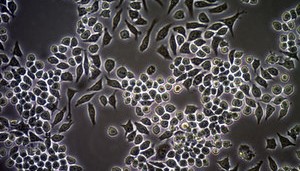Featured Products
Our Promise to You
Guaranteed product quality, expert customer support

Immortalized Murine Cells
 Murine cells show frequent spontaneous immortalization in contrast to human cells that almost never spontaneously immortalize. Addition of DNA tumor viruses alone, mild mutagen treatments and even deregulated expression of cellular genes such as c-myc are enough in certain murine cells for immortalization. Crisis stage is either not observed or is very subtle in case of murine cells, due to their ability to immortalize spontaneously, were exploited to identify genes associated with cellular mortal or immortal phenotypes. Independent studies on spontaneously immortalized clones from different strains of mouse have shown that most of these clones had one or both mutant p53 alleles, in contrast to their parent cells which expressed wild type p53. The immortal clones which expressed wild type p53 were found to be defective in one or other elements of the pRb pathway.
Creative Bioarray can provide you immortalized murine cell lines with an integrated platform for meeting the needs for virtually any relevant research project.
Murine cells show frequent spontaneous immortalization in contrast to human cells that almost never spontaneously immortalize. Addition of DNA tumor viruses alone, mild mutagen treatments and even deregulated expression of cellular genes such as c-myc are enough in certain murine cells for immortalization. Crisis stage is either not observed or is very subtle in case of murine cells, due to their ability to immortalize spontaneously, were exploited to identify genes associated with cellular mortal or immortal phenotypes. Independent studies on spontaneously immortalized clones from different strains of mouse have shown that most of these clones had one or both mutant p53 alleles, in contrast to their parent cells which expressed wild type p53. The immortal clones which expressed wild type p53 were found to be defective in one or other elements of the pRb pathway.
Creative Bioarray can provide you immortalized murine cell lines with an integrated platform for meeting the needs for virtually any relevant research project.
Description:
Description:
Description: The Immortalized Rat Conjunctival Epithelial Cells (CJ4.1A) were derived from primary...
Description: Hepatic sinusoidal endothelial cells (HSECs) are an unique sub-population of liver...
Description: The arachnoid cells are important in the maintenance of apical-basal polarity and...
Description: Olfactory bulb ensheating glia (OEG) is valued for its unique properties in promoting...
Description: In aldosterone-sensitive distal nephron (ASDN), mineralocorticoid receptor (MR) and...
Description: As messengers bridging the innate and adaptive immune system, the conventional tissue-resident...
Description: Enteroglial cells (EGCs) have a key role in the inflammatory response in the enteric...
Description: Lutropin/choriogonadotropin (LH/CG) receptor, a receptor uniquely expressed in ovarian...
Description: The Immortalized Mouse Astrocytes- SV40 T (IMA 2.1) is a suitable cell line for studies...
Description: Clara cells play a role in the maintenance of normal bronchiolar epithelium by secreting...
Description: Homeostasis of the central nervous system (CNS) is maintained by the blood brain...

